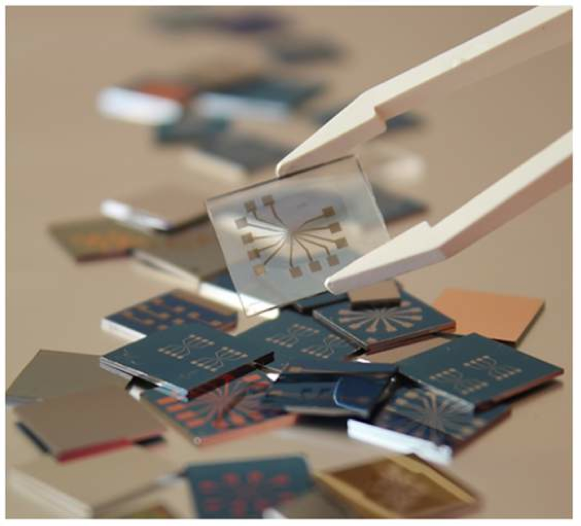“Nanostructuring of Devices for Nanoscience Applications”, PhD Thesis by Libe Arzubiaga
Libe Arzubiaga, Pre-doctoral Researcher at the Nanodevices Group at nanoGUNE, receives her PhD at the University of the Basque Country (UPV/EHU) after the defense of her thesis project on Monday 16 March 2015. Her research work, entitled “Nanostructuring of Devices for Nanoscience Applications”, has been developed under the supervision of the Nanodevices Group Leader and Ikerbasque Research Professor Dr. Luis Hueso.
 Picture: Pau Bou i Grau
Picture: Pau Bou i Grau
Arzubiaga has focused her thesis on the fabrication of nanostructured devices for applications in different fields of nanoscience, from plasmonics to spintronics and nanoelectronics.
The researcher first optimized the electron beam lithography process on substrates with different mechanical or electrical properties, such as insulating oxides, pyrex, or electron-transparent silicon nitride membranes, achieving minimum sizes of around 20 nm for constrictions and nanogaps. She also prepared electronic devices on graphene, including substrate preparation by physical exfoliation of graphite flakes at a whole wafer scale, utilising, in this case, a high energy electron beam (working at 100 kV), with which structures with minimum sizes or around 10 nm could be achieved.
On the other hand, Arzubiaga optimized the nanostructuring of devices by electromigration, as a technique complementary to electron beam lithography. This technique consists on breaking metallic wires of nanometric cross-section by electrical fatigue, allowing obtaining structures that are beyond the capabilities of most state-of-the-art lithographic techniques. Nanogap electrodes, nanoconstrictions, and quantum dots are some examples of the obtained structures.
Finally, Arzubiaga combined all the optimized fabrication methods for obtaining single-electron transistors and spintronic devices. On one hand, she obtained palladium-based devices (including pure palladium and nickel palladium alloy) showing single electron transport characteristics at liquid-helium temperature. These devices were intended for the study of electronic correlations in metals and alloys.On the other hand, lateral spin valves with nanoconstrictions were fabricated. In these devices pure spin currents are created and transported through a non-magnetic metallic channel, which consisted of a constricted copper nanowire. She patterned these constrictions by electron beam lithography and then modified them by electromigration. After consecutive electromigration stages, in which the constriction was gradually narrowed, the evolution of the spin current, was measured. This still unfinished project aims at studying the transport of pure spin currents through nanostructured metallic channels containing either nanoconstrictions, nanogaps, or quantum dots.
An international committee including leading researchers in the field was selected to assess the research project:
- Maria Luisa Fernandez Gubieda Ruiz (Universidad del País Vasco/Euskal Herriko Unibertsitatea, Spain)
- Francesc Perez Murano (Consejo Superior de Investigaciones Científicas, CSIC, Spain)
- Jose Maria De Teresa (Consejo Superior de Investigaciones Científicas, CSIC, Spain)
- Clemens Benjamin Winkelmann (Universidade de Grenoble, France)
- Miren Nerea Zabala Unzalu (Universidad del País Vasco/Euskal Herriko Unibertsitatea, Spain)
The defense consisted of a presentation by the candidate of the main aspects of the research project followed by a long discussion about the questions that each one of the members of the committee raised around the research works that have been carried out during the whole PhD period. After its final deliberation, the committee decided to award the candidate the Doctor Degree with the highest mention existing at the Spanish University (cum laude).
